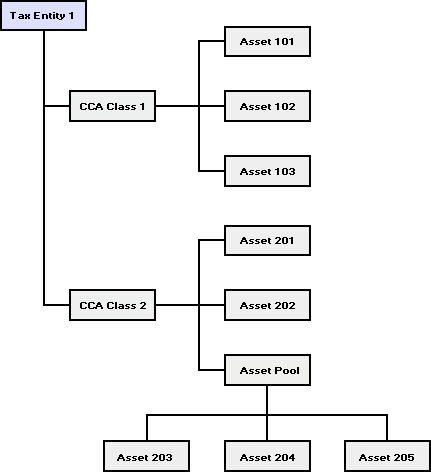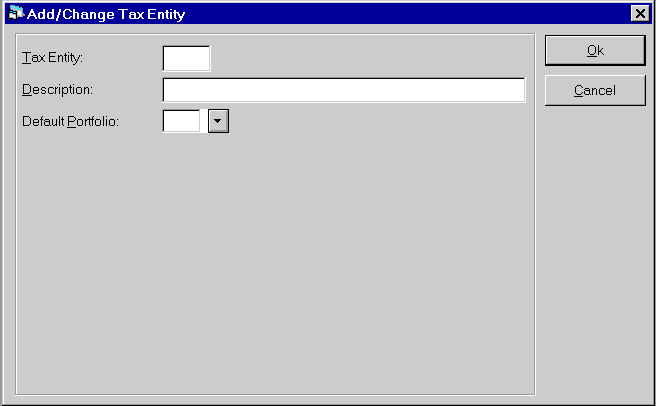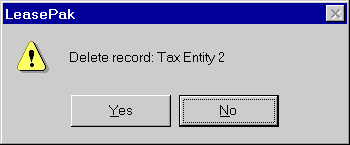Tax Entity [U0224]
Contents
Introduction
A tax entity owns a set of assets of different classes and is entitled to claim Capital Cost Allowances on that set of assets. An asset may be placed in a separate class or in a pool of similar assets. The figure below illustrates the hierarchical structure of tax entity, classes, pools, and assets within one tax entity.

Tax entity need not correspond to "accounting unit" of LeasePak, i.e., more than one P/C/R/O may be under one common tax entity. A tax entity must exist before assets may be added for the tax entity. The Tax Entity update [U0224] is used to add, change, or delete tax entities.
There is no limit to the number of tax entities that may be established.
Tax Entity Menu

This screen is used to add, change or delete the Tax Entity update [U0224] option.
It is possible to prevent a user from deleting Tax Entity data, in which case the delete option does not appear on that user's screen. On the Security table [U0706] for the user, an N in the ALLOW MASTER FILE DELETE PRIVILEGE field prevents deleting data.
Field Descriptions
- SELECT ONE OPTION
ADD
This option is used to add a tax entity for CCA purpose.CHANGE
This option is used to change information for a tax entity.DELETE
This option removes a tax entity from LeasePak files. The tax entity may not be removed if there are assets attached to it.
Add/Change Tax Entity

This screen is used to indicate the tax entity being added or changed.
Field Descriptions
- TAX
ENTITY
Tax entity code could be a number, an acronym, or any other unique set of alphanumeric characters. If changing a tax entity, the code must already exist in the system.
- DESCRIPTION
Enter or change the description of the tax entity.
- DEF
PORT
Enter or change a default portfolio for the tax entity. The Capital Cost Allowance module must be used in the default portfolio, as established through the Modules Customization screen of the Portfolio update [U0212].
Delete Tax Entity

This screen appears once the tax entity and the delete button have been selected. This message allows the user to verify that the correct record is being deleted from the system. The description and the default portfolio associated with the tax entity code is displayed and should be verified as the correct tax entity to delete.
LeasePak Reference Guide
©
by McCue Systems Incorporated. All rights reserved.
The information contained in this document is the property of McCue Systems, Inc. Use of the information contained herein is restricted. Conditions of use are subject to change without notice. McCue Systems, Inc. assumes no liability for any inaccuracy that may appear in this document; the contents of this document do not constitute a promise or warranty. The software described in this document is furnished under license and may be used or copied only in accordance with the terms of said license. Unauthorized use, alteration, or reproduction of this document without the written consent of McCue Systems, Inc. is prohibited.